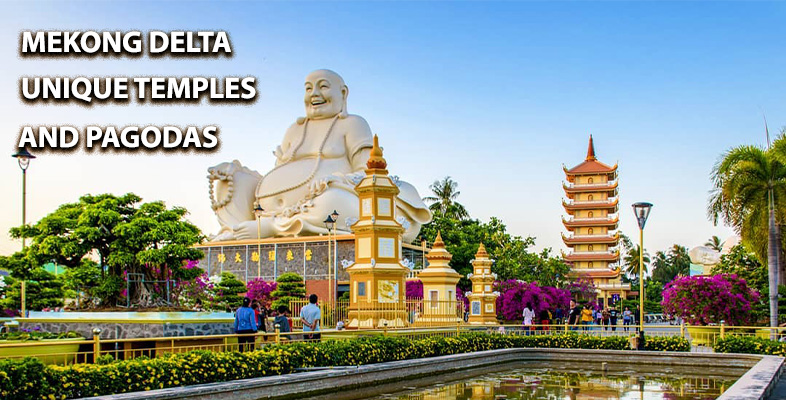
- On 6 August, 2020
- In ALL BLOGS VIỆT NAM BLOGS
- Tags Tags: mekong delta, pagodas, temples
MEKONG DELTA’S 10 UNIQUE TEMPLES AND PAGODAS
Temples and Pagodas are among Mekong Delta’s most popular attractions, where travelers can marvel at intricate carvings and well-preserved architecture as well as experience the local culture during their holiday. A predominantly Buddhist country, there are thousands of pagodas and shrines dedicated to the revered icon.
Unlike most tourist spots, you don’t need to pay a fee to enter most of these temples, but donations are warmly welcomed. Visitors are required to dress appropriately and remove their shoes before entering prayer halls.
Here are the list of 10 unique temples and pagodas that worth a visit!
- Vĩnh Tràng Pagoda, Tiền Giang
- Kiến An Cung Temple, Đồng Tháp
- Âng Pagoda, Trà Vinh
- Floating Pagoda of Coconut Religion, Bến Tre
- Bình Thủy Temple, Cần Thơ
- Bà Chúa Xứ Temple, An Giang
- Tôn Thạnh Pagoda, Long An
- Quan Âm Phật Đài Pagoda, Bạc Liêu
- Tam Bảo Pagoda, Kiên Giang
- Chén Kiểu Pagoda, Sóc Trăng

Vĩnh Tràng Pagoda is one of the most famous ancient pagodas in Mekong Delta, located just about 3km from city of Mỹ Tho, Tiền Giang Province. It was built in 1849 by a Buddhist monk named Huệ Đăng using funds collected from practitioners.
It is recognized as a national historical and cultural relic by the government. This pagoda is in an area of 2,000m2 with many beautiful trees surrounded such as ornamental tree gardens, ancient trees and bonsai, creating a peaceful and fresh atmosphere. Besides, the architecture of the pagoda is a combination of Asian and European architecture, creating a splendid beauty, solemnity, but purity.
The beautiful structure features a mixture of Chinese, Vietnamese and Angkor (Cambodian) architectural styles. The pagoda consists of five buildings, two ornamental yards and 178 pillars. The extremely beautiful structures in the pagoda are two triumphal arches bearing an art of inserting bottle and porcelain fragments which create harmonious pictures illustrating the Buddha’s legendaries.
Inside the pagoda, there is a set of pictures “eight angels riding on animals” another set of statues of the Amitabha Holy Trinity carved in bronze, as big as a man, and more particularly, the set of the eighteen Arhants, wood carving work, is the only one in the west of South Vietnam, made by a number of artists in 1907. Vinh Trang Pagoda also houses 60 precious statues made from copper, wood and terracotta. The most valuable collection is the 18 arhats made from jackfruit tree wood in 1907. Additionally, the pagoda has a bell that was cast in 1854.
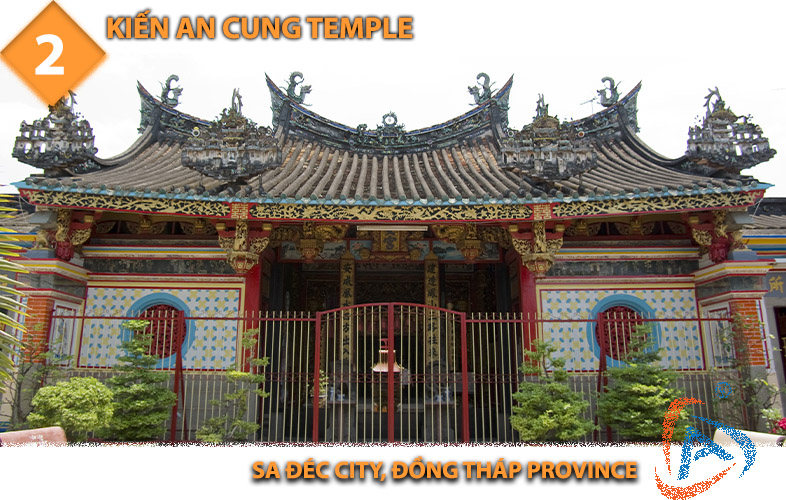
Kiến An Cung, also known as Mr. Quách Pagoda, is located in the center of Sa Đéc City, Đồng Tháp Province. It was built between 1924 and 1927 by Huỳnh Thuận, Huỳnh Thủy Lê’s father, and a group of Chinese people from Fujian Province living in Sa Đéc at that time. The pagoda is characterized by Chinese architecture with a unique traditional culture; Kiến An Cung has been recognized by the Ministry of Culture and Information as a national-level historical-cultural relic on April 27, 1990.
The pagoda, whose front faces the Cái Sơn River, was built as the shape of the Chinese word meaning merit including three compartments of which the largest was used for the shrine. The roof was made meticulously with three layers, first tiles, second bricks and third more tiles. Most of the material used for building the pagoda was brought from Fujian Province. Finely carved gilded woodwork and delicate frescoes flank the altar, which faces an open-air courtyard (the “celestial well”) where incense is burned to facilitate contact with the gods.
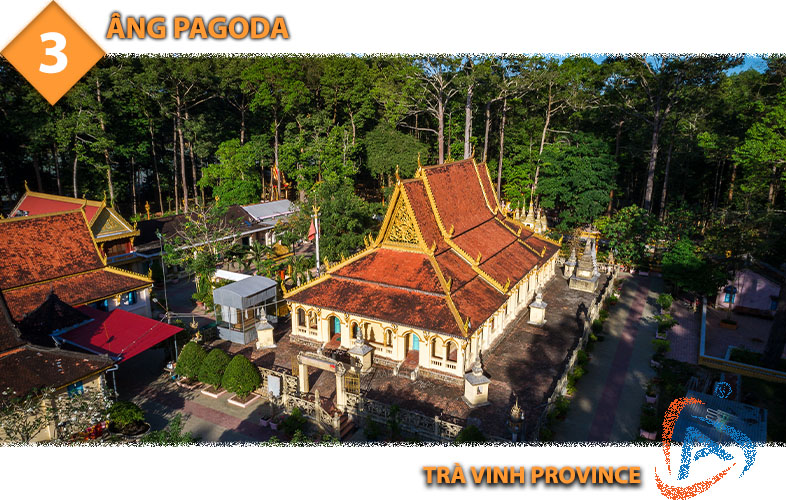
Âng Pagoda, also called Angkorajaborey Pagoda, is an ancient Khmer-styled pagoda in Trà Vinh Province. It is an ideal place for enthusiasts of Khmer architecture and culture in Mekong Delta.
It was built in an original architectural style which harmonizes natural scenery with typical Khmer art and decoration. The pagoda deeply expresses the character and colors of the Angkor culture. The central chamber, the roof’s eaves, the fence pillars around the central chamber and other details are drawn and carved with flowers and vignettes of the Snake God Naga with a curved tail, the statues of bird-headed people, snakes and birds, the head of the God Bayon with four faces and the Ogress Yeak wearing an armor.
There are many centuries-old trees around Âng Pagoda. They all create an innocent beauty and a pure atmosphere, which attract visitors from everywhere whenever they have a chance to visit this pagoda.
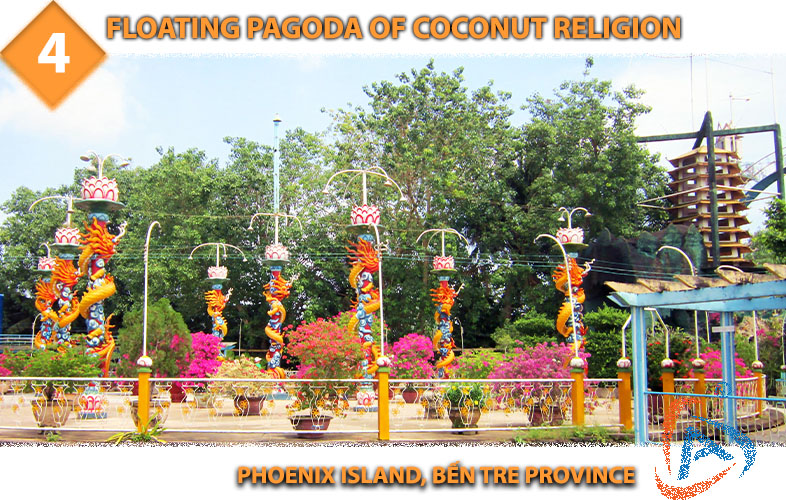
The Coconut Religion was founded in 1963 by Vietnamese scholar Nguyễn Thành Nam (1901-1990). Nam, who attended a French university, established a floating pagoda near the Phoenix Island on the Mekong River. It is alleged that Nam consumed only coconuts for three years; for that period he also practiced meditation on a small pavement made from stone.
According to an official estimate, the Coconut Religion has 3,516 followers in the Mekong Delta’s Định Tường Province at that time.
The Coconut Monk, appearances notwithstanding, is not the product of an Oriental fairy tale. In fact he is a former well-to-do French-educated engineer. Since his retirement from engineering he has been especially attracted to publicity, Jesus, Buddha and the meat and juice of coconuts. It is believed that he subsists, as a coconut vegetarian, on nothing but coconuts.
The site today sits largely forgotten and in decay. The river has silted up beneath the once-floating temple, so that it’s not floating anymore. But the colorful pillars, minarets and grottos, though weather-stained and peeling, still remain in place. And hanging from a white metal tower hangs his very own Apollo 11, testament to his cosmic aspirations. The only moon it is ever likely to land on, though, is the husk of some fallen coconut beneath.
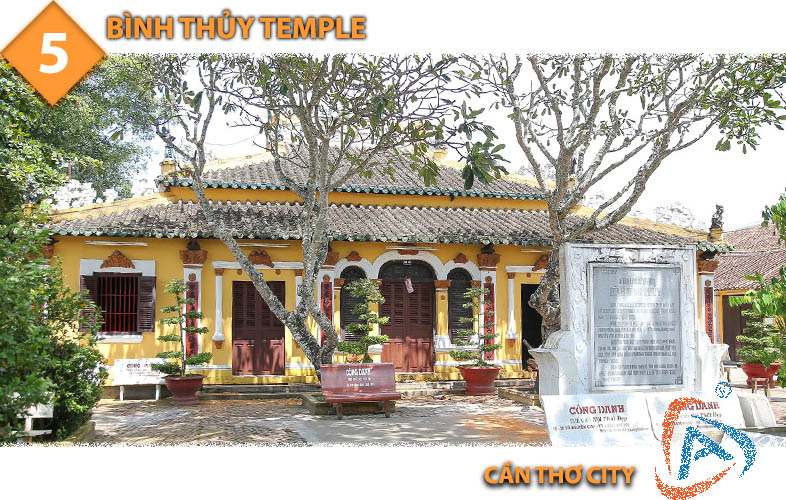
Bình Thủy Temple was built in 1844, located in an area of 4000sqm surrounded by green trees in Bình Thủy District, Cần Thơ City. It is a unique architecture imbued with Southern culture, over a century; Bình Thủy Temple still preserves intact the quintessence of the carved patterns on the interior system. Unlike other temples in Việt Nam, Bình Thủy Temple not only worships the tutelary god but it also worships other gods as: God of Agriculture, God of Forest, God of River and Tiger God.
The Temple is built on a high ground. The front and back of the houses are in a square shape, and each direction has 6 rows of big, slippery, slightly sloping columns. Inside the temple, there is an altar system which is appropriately arranged. Each altar is separated with walkways. On both sides of the altars, there are columns carved with eye-catching patterns like dragons, flowers, peonies and more. Along with that is the system of couplets, diaphragm, and hammocks with traditional patterns such as dragon, phoenix, chrysanthemum and apricot. All of the magnificent arts have made the space of the communal temple more charming with the ancient vibe, sacred and full of aesthetics. In 1989, it was recognized as a National architectural and artistic vestige.

According to a legend, in the early 1800s, villagers found a statue of a lady dating to the 6th century in the forest. They built a temple in her honor, hoping that she would bring them better crops and better lives.
Bà Chúa Xứ Temple was built in 1820, at the foot of Sam Mountain, Châu Đốc Town, An Giang Province. The Temple is constructed according to the Chinese Vietnamese character Quốc which means “country”. It has 4 square roofs, roofed with blue pile-shaped tiles. This is why the marble statue of Bà Chúa Xứ, meaning “country lady” is worshiped. In the festival, worshipers touch her statue and ask for her protection and benediction.
Bà Chúa Xứ temple festival (also known as worshiping goddess festival) is a famous festival in An Giang province, which is held largely each year. This festival was recognized by the Ministry of Culture, Information and Tourism as a national festival in Việt Nam in 2001.

The ancient pagoda of Tôn Thạnh is located in Cần Giuộc District, Long An Province. The 200 year-old pagoda is the place where Nguyễn Đình Chiểu, a great poet and patriotic scholar lived and created the most celebrated works in Vietnamese literature.
After being restored several times, the pagoda has experienced a lot of changes. It now consists of a complex of a worshiping hall, a sanctum, a preaching house and corridors in the west and the east.
Particularly, the pagoda only preserves the old architectural style with a system of four pillars in the main sanctum, several Buddhist statues from the early 19th century, parallels and the most valuable statue of Ksitigarbha Bodhisattva which is 110m high and is made from bronze.

Pilgrims to the Mekong Delta Province of Bạc Liêu are recommended to make a stop at a Buddhist pagoda with an 11-metre-tall Bodhisattva statue.
Situated eight kilometers from Bạc Liêu City, Quan Âm Phật Đài Pagoda in Nhà Mát Ward has been one of the most frequented pilgrim destinations in the Mekong Delta for nearly half a century. The statue, which looks out to sea, is referred to by local residents as Nam Hải’s Mother.
Built in 1975, the pagoda is home to the Mekong Delta’s largest spiritual festival that takes place every year from the 22nd to 24th of the third lunar month to commemorate the birth anniversary of the Goddess
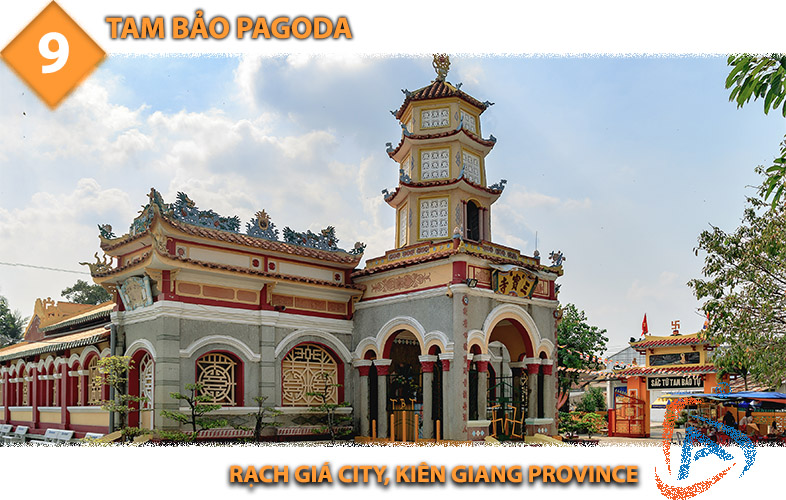
In the past three centuries, Hà Tiên town in the Mekong Delta province of Kiên Giang has been a popular location for tourists attracted to its stunning landscapes and pilgrims to Sắc Tứ Tam Bảo Pagoda.
Mạc Cửu built the pagoda in 1730 with the initial aim of giving his mother a place to spend the rest of her days studying Buddhism. It was renovated in 1930 bringing a curved roof, a lake out front, a flower garden and dormitory for monks and Buddhist nuns. The yard is shaded by many large trees.
The pagoda was formerly led by monks but from 1974 nun Thích Nữ Như Hải was appointed as the pagoda leader and since then it is dedicated to nuns. The pagoda has been renovated many times in recent years.
Visiting the pagoda, visitors will witness a large Bodhisattva statue in the yard. There is also a 300-year-old bronze Sakyamuni statue in the sanctum and a large bell donated by Mạc Cửu whose mother’s tomb is still located onsite.
Many tourists visit the pagoda not only to admire the peaceful atmosphere but also to join in the activities with nuns. The pagoda hosts many programs for youngsters with an aim at providing them soft skills and teaching them a moral and healthy lifestyle.
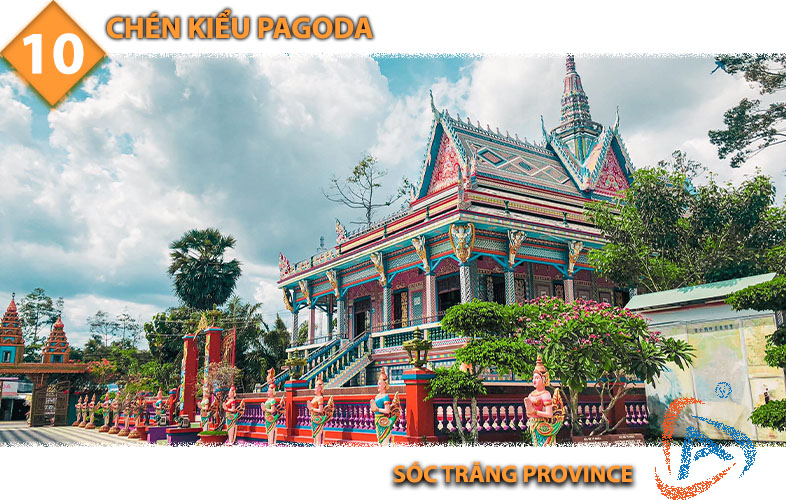
Chén Kiểu is a Khmer-styled pagoda, located in Mỹ Xuyên District, just 10 kilometers from Sóc Trăng Town. The temple was acknowledged as a national cultural relic in 2012. It has the unique architectures when all columns and wall surfaces for both the interior and exterior are stunningly decorated with about 30 tons of broken porcelain pieces involving vases, bowls, and plates. The sanctum contains 16 pillars carved with icons of the legends of the Khmer culture. The gate is decorated with two huge stone lion statues.
There are a number of the Buddha statues of various sizes in the garden of Chén Kiểu, each represents different teachings of Buddhism. The reclining Buddha represents the peacefulness of entering Nirvana and of getting enlightenment. In the garden of the pagoda, there are many small thatched huts on stilts; these are for local pilgrims to meditate to clear themselves from sins or illnesses.